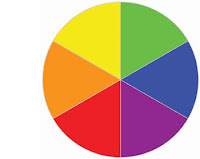
A few days back, while commenting on the new color “Micro” cameras from Cognex, I suggested that not many machine vision applications actually need color. I thought it might be useful to elaborate on this, so I’ve been busy trawling the internet for some useful links.
Surprisingly, there’s little out there that helps, but one of the best articles is “Modifying Light” on the Advanced Illumination web site. (It’s not credited but I’m guessing the author was Daryl Martin.)
After touching briefly on bandpass filters (which allow only light of a narrow wavelength range to reach the sensor,) the article gets to the color wheel. The point here is that shining an “opposite” color on a target will make the target appear black. The example given is of a red “Stop” sign. Under green light the red color appears black. In other words, none of the incident light is reflected back to the camera. (It might help to remember that we see a color because that particular wavelength is reflected from a surface while all the other incident wavelengths are absorbed.) Conversely, if you illuminate the part with a light of its own color, all the incident light will be reflected back and the part will appear white.
So if you’re trying to get strong contrast between an object of a particular color and its background, one method is to pick the “opposite” color from the color wheel. That will make your target appear black. Alternatively, make it white by using the same color.
Same – white. Opposite – dark.
Surprisingly, there’s little out there that helps, but one of the best articles is “Modifying Light” on the Advanced Illumination web site. (It’s not credited but I’m guessing the author was Daryl Martin.)
After touching briefly on bandpass filters (which allow only light of a narrow wavelength range to reach the sensor,) the article gets to the color wheel. The point here is that shining an “opposite” color on a target will make the target appear black. The example given is of a red “Stop” sign. Under green light the red color appears black. In other words, none of the incident light is reflected back to the camera. (It might help to remember that we see a color because that particular wavelength is reflected from a surface while all the other incident wavelengths are absorbed.) Conversely, if you illuminate the part with a light of its own color, all the incident light will be reflected back and the part will appear white.
So if you’re trying to get strong contrast between an object of a particular color and its background, one method is to pick the “opposite” color from the color wheel. That will make your target appear black. Alternatively, make it white by using the same color.
Same – white. Opposite – dark.





No comments:
Post a Comment